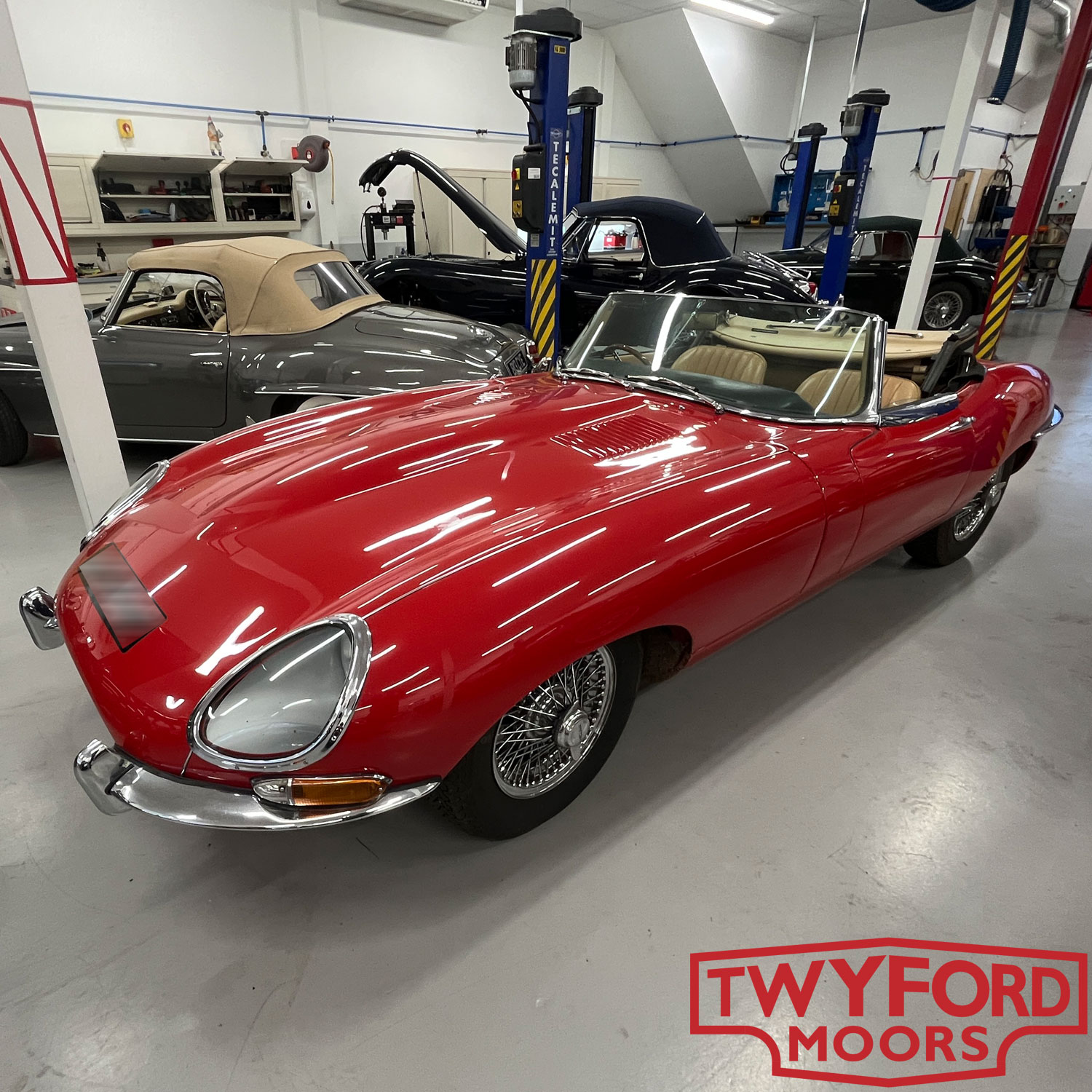Sumps, Subframes, and Servicing – Workshop Update
It has been a little over a month since our last update, and so much has been happening—too much to share in just one post! As you can see from the photo, the workshop is extremely busy, and the storage floor upstairs is full. We are working hard to get ahead with spring servicing for many of our customers while continuing to push forward with long-term projects and restorations. Managing all of this can be a challenge, but our dedicated team is doing a fantastic job of keeping the diary organised and ensuring work flows smoothly.
Many of you may have seen that we have been recruiting for a mechanic. We were thrilled to receive many applications, but as you will appreciate, finding the right person to look after these cars is no easy task. We are pleased to say that we have now found the perfect candidate, who brings many years of experience working on both classic and modern Jaguars. This addition will further strengthen our team and the services we can offer.
In this update, we take a look at a couple of cars suffering from bad oil leaks, one of the rarest XK150s we have ever had in, a few non-Jaguar classics, and some exciting new products.
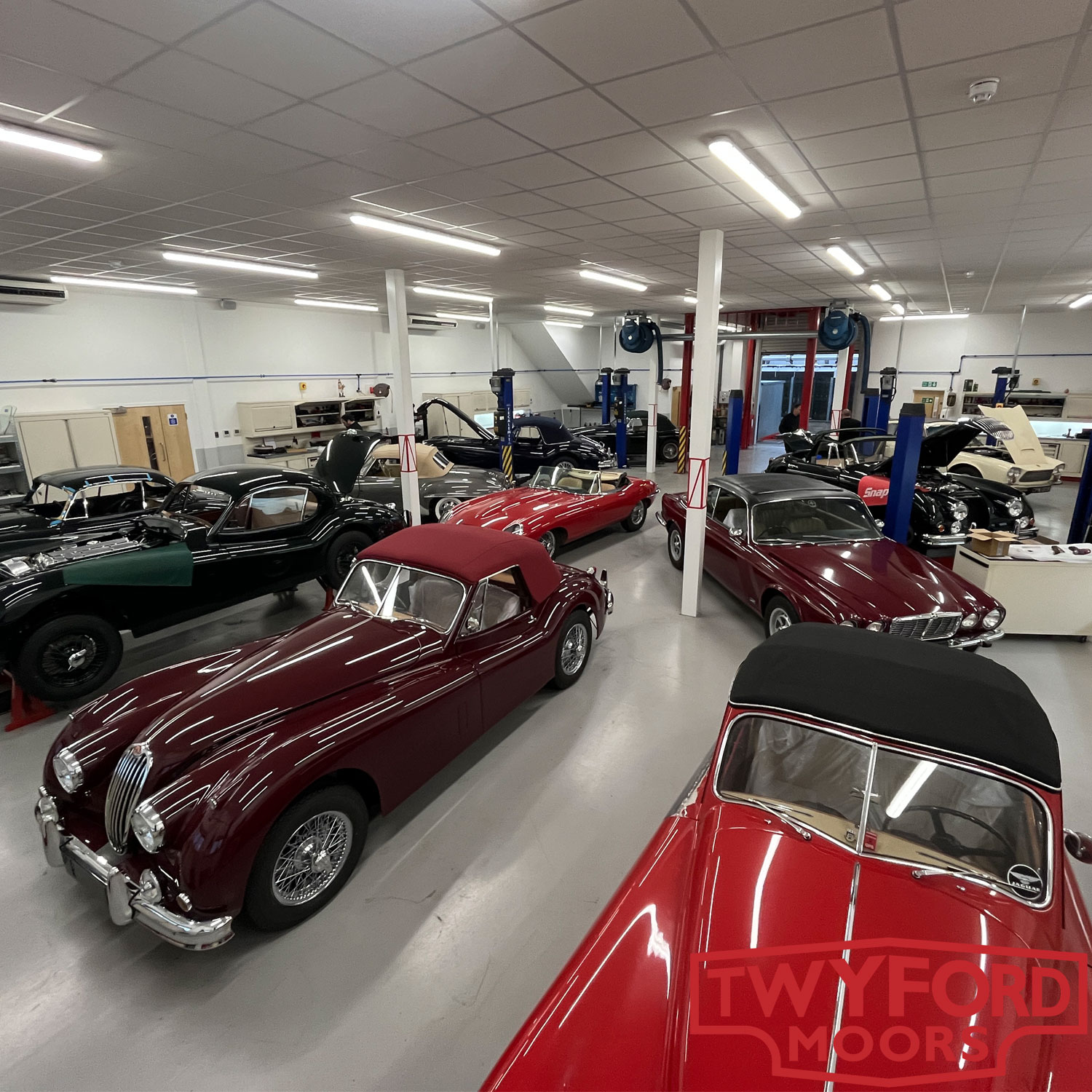
A Very Rare XK150
This Jaguar XK150 has to be one of the most unusual and rare XKs out there. It is an original UK-market, right-hand-drive OTS, which alone makes it one of just 93 cars built. Adding to its rarity, it is a 3.8-litre non-S model, making it one of only two XK150 OTS 3.8s to be built in right-hand drive—and the only home-market car, with the other being exported to Ghana. We understand that there may be a third car, though its status is uncertain, as it was converted to S specification at the factory.
One final oddity about this car is that it retains its original factory steel wheels and spats. This was an option for the XK150 but was exceedingly rare, as most buyers at the time opted for wire wheels. This combination of factors makes this XK150 utterly unique.
The reason for the car's visit was to have the clutch replaced, along with a few other minor jobs. To change the clutch on an XK150, it is necessary to remove the engine and gearbox from the car, a process that can only be done from above. This operation requires great care but is made much easier with the right equipment and experience.
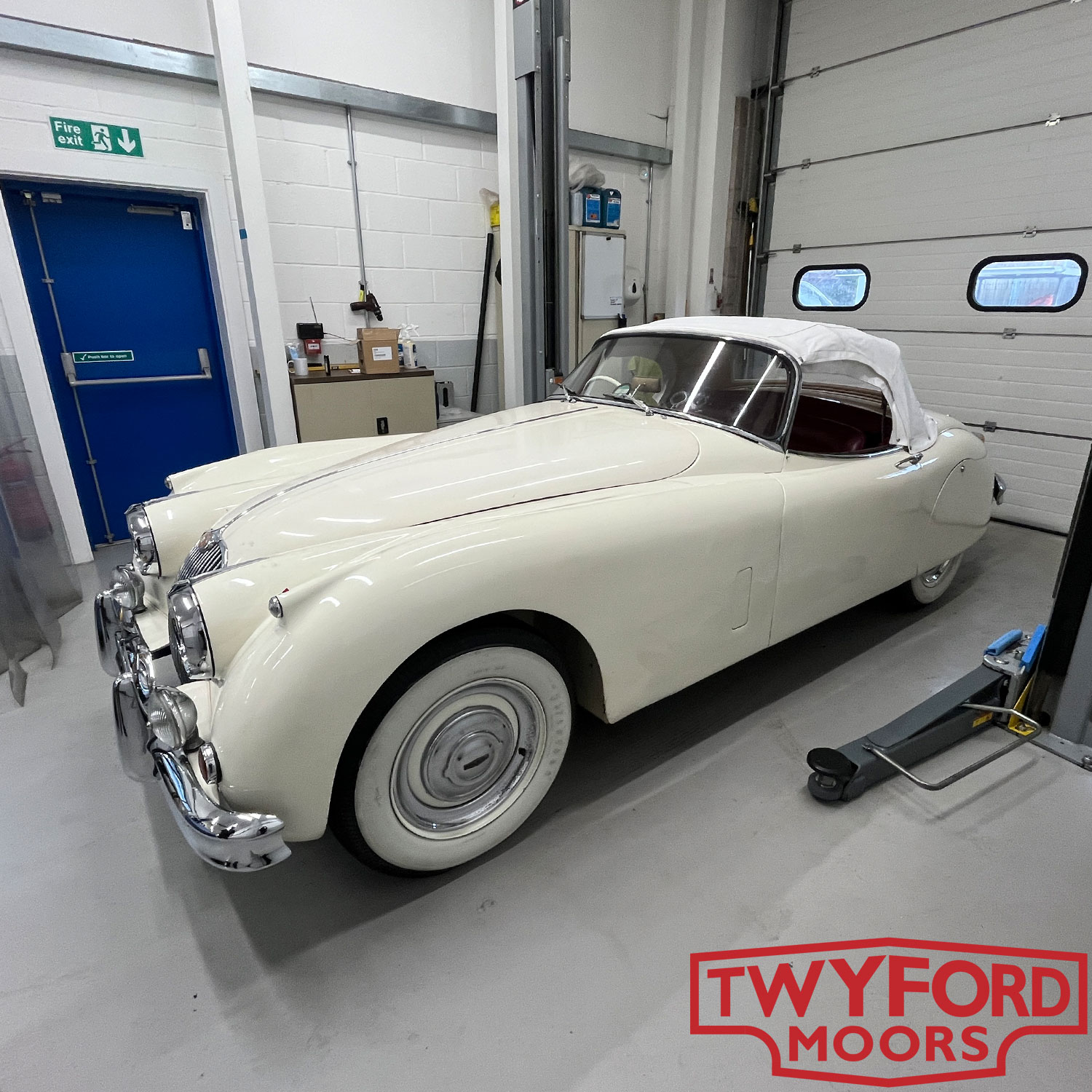
Jaguar E-Type Wiper Fault
Please excuse the rather poorly focused photo—it was meant to highlight the tiny brown component in my hand, but my photography skills let me down on this occasion! Despite the poor image quality, I felt it was worth sharing, as it illustrates how we can often be searching for a needle in a haystack, with many hours spent tracing a fault to a tiny component.
In this case, the E-Type in the background came in with a windscreen wiper fault. Initial investigations involved checking the wiring, the switch, and the linkage while everything was still in place. When all of these checked out fine, the motor was removed and tested on the bench. The issue was not immediately apparent, but after a few tests—and with the motor covers removed—our eagle-eyed electrician spotted that this tiny fibre-retaining clip was broken.
There are two of these clips in the motor, and they hold the spring that tensions the motor brushes in place. Without this clip, the brushes were not being held properly. After fitting a replacement second-hand clip and cleaning everything up, the motor was back in perfect working order.
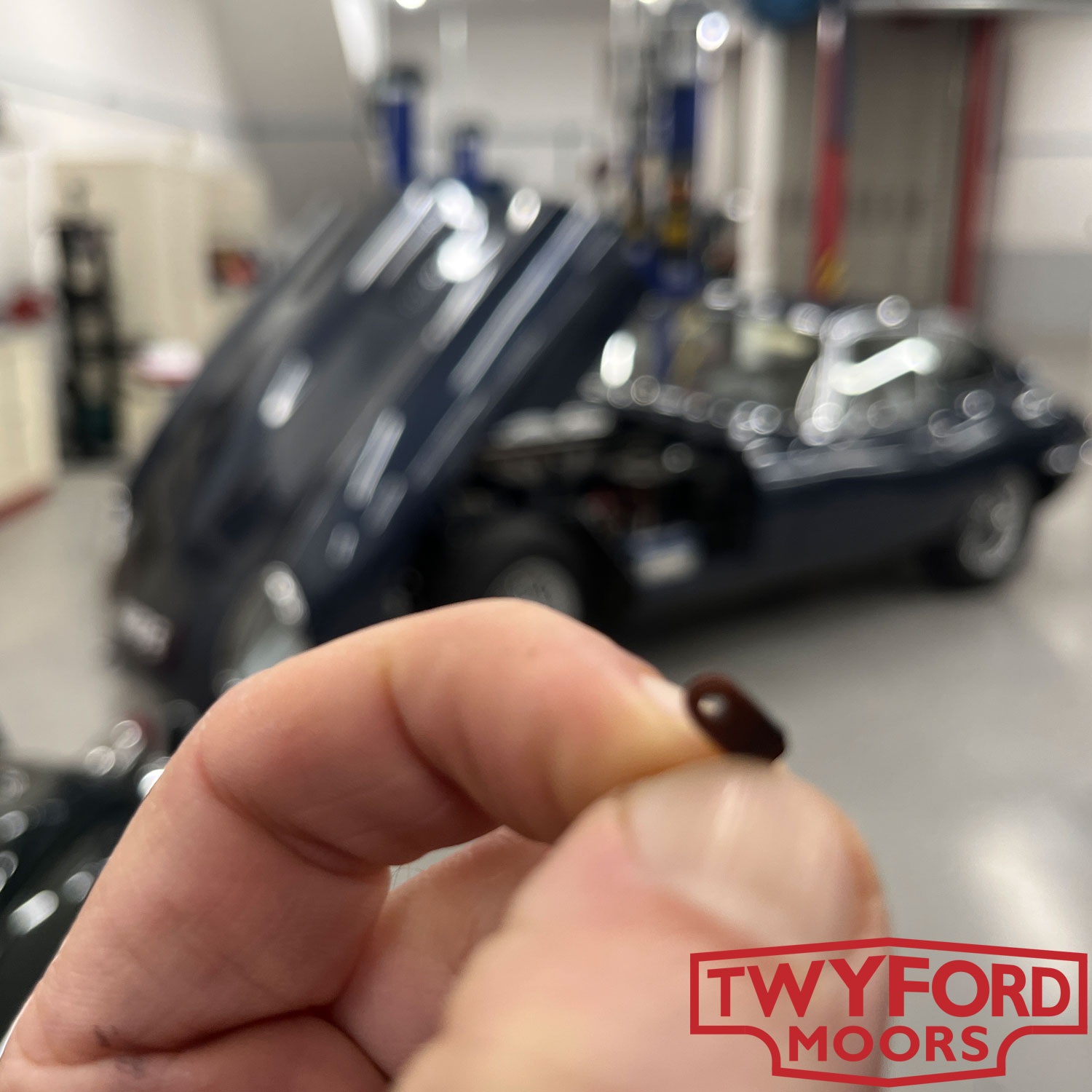
Daimler Fifteen Head Gasket
As ever, we always have a few non-Jaguar classic cars in the workshop. This charming Daimler Fifteen from the 1930s is a perfect example. These Daimler Fifteens are rather interesting cars for their time. They were Daimler’s response to the poor economic conditions of the 1930s and were something of a budget option compared to what had come before. The name itself was derived from its tax rating of 15hp, which one imagines was a very deliberate marketing move.
The sweet little straight-six engine has tiny cylinders, with a displacement of just 1.8 litres. The engine also features overhead valves, which was quite advanced for the time, putting it up there with the SS100 in terms of engine technology.
This Daimler is with us due to a failed head gasket. The owner, who also has a Daimler V8 (Jaguar MkII saloon style) that we look after, had struggled to find a reliable garage to work on this Fifteen and asked if we could help. This is often how we find ourselves caring for different marques. With the head removed and everything checked over, we are now having a new set of head studs specially made for it.
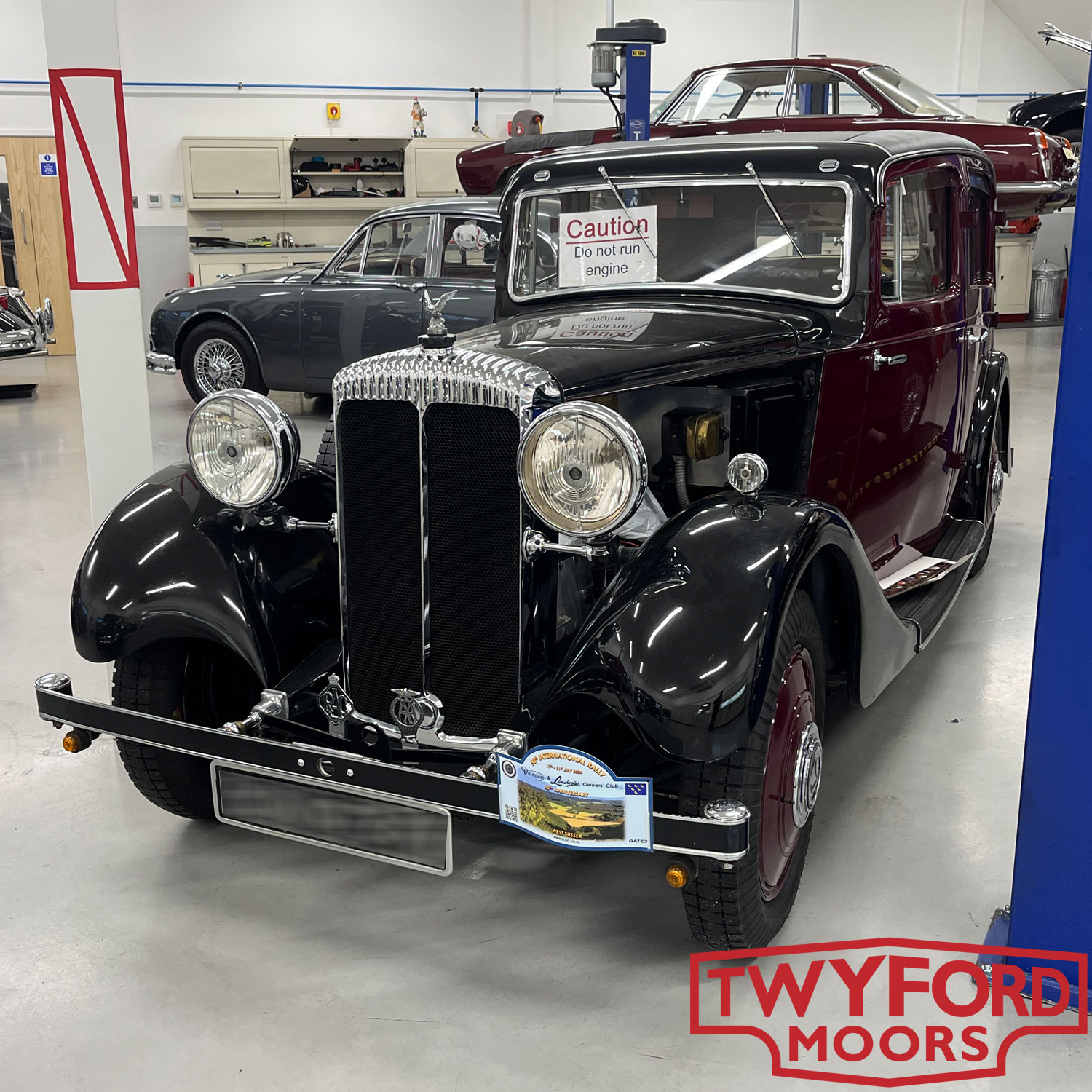
Jaguar XK150 Servicing
This Jaguar XK150 DHC is an absolute delight! We restored it some twenty years ago, yet it still looks as fresh today as it did back then—despite the rain. We believe there is no better advert for our restorations than being able to show people how well cars like this stand the test of time and that they are built to be used.
Although this car looks stunning, it is also a practical classic that can be driven and enjoyed with confidence. Even in poor weather, drophead coupés are practical, with hoods and windows that genuinely keep the rain out. These cars keep up with modern traffic well, and with a few upgrades—such as electronic ignition, an electric cooling fan, and electric power steering—they can handle modern driving conditions with ease.
The real ace up the sleeve of this particular XK150 is its gearbox. When it was restored, we fitted our upgraded automatic gearbox. This is a modern automatic transmission with an overdrive fourth gear and a lock-up clutch in the torque converter, providing a solid connection between the engine and gearbox to improve both performance and fuel economy.
This is a fantastic upgrade for an XK and helps keep these cars usable for drivers who may be finding it difficult to operate a clutch.
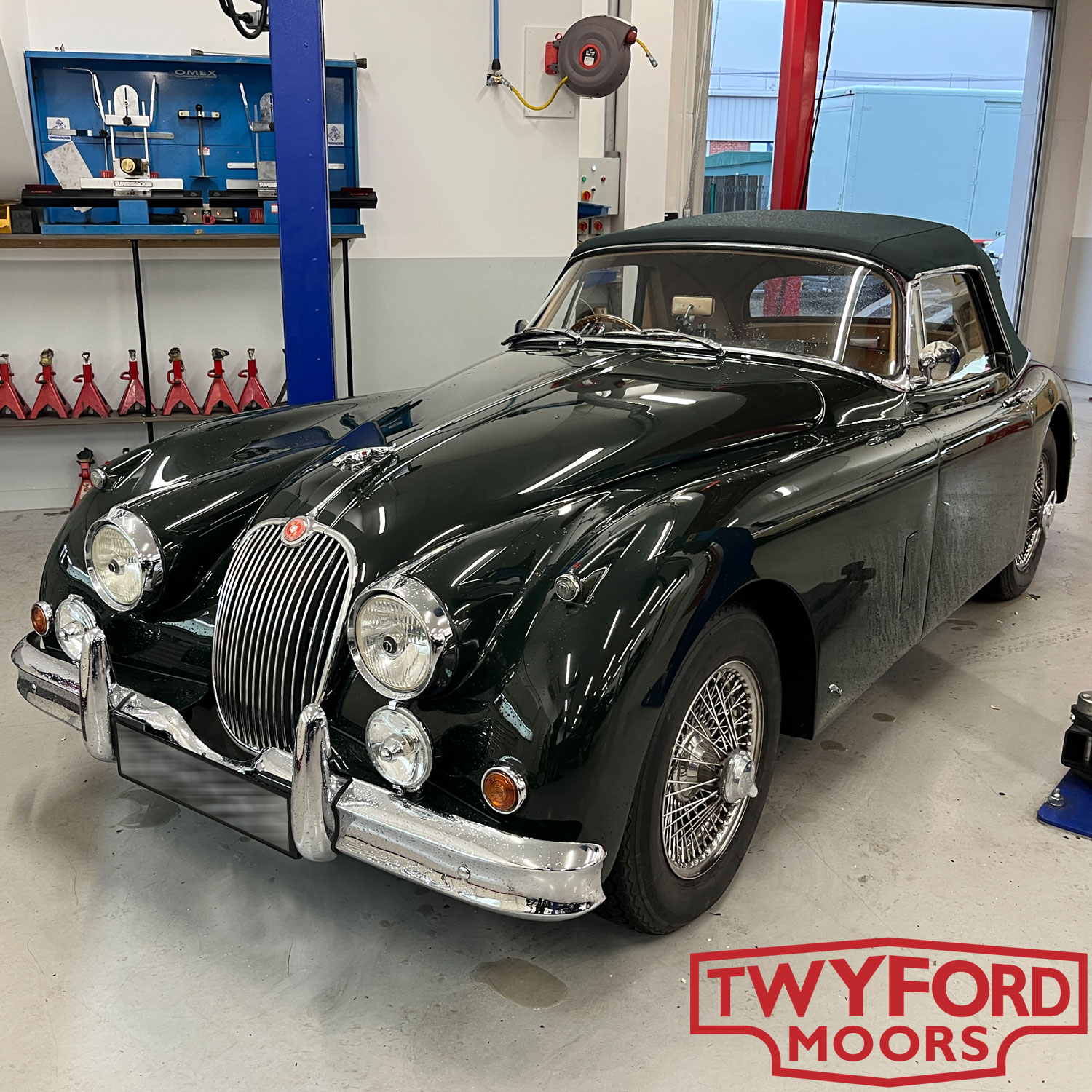
Beautiful Brakes
How lovely is this? In my hand here is one of the first batch of our Twyford Moors aluminium XK150 brake pistons. These are manufactured for us by a leading brand in the industry, who are also producing our four-pot front brake upgrades and our Jaguar E-Type handbrake upgrades.
These brake pistons are a direct replacement for the original Dunlop pistons, making this a reversible upgrade, and they are available in sizes to fit XK150 front and rear, as well as E-Types and MkIIs. Machined from billet aluminium, these brake pistons improve both performance and pedal feel, and their construction makes them less prone to leaks and dirt ingress.
The pistons photographed here are for the rear of an XK150. When combined with our four-pot aluminium front callipers, they significantly improve an XK150’s stopping power. For the XK120 and XK140, we offer a front disc brake upgrade along with a servo; however, we recommend retaining the rear drum brakes for most applications. Effective brakes are absolutely vital for any classic in modern driving conditions. Whether you need repairs and setup to maximise the performance of original braking systems or an upgrade for modern use, we have you covered.
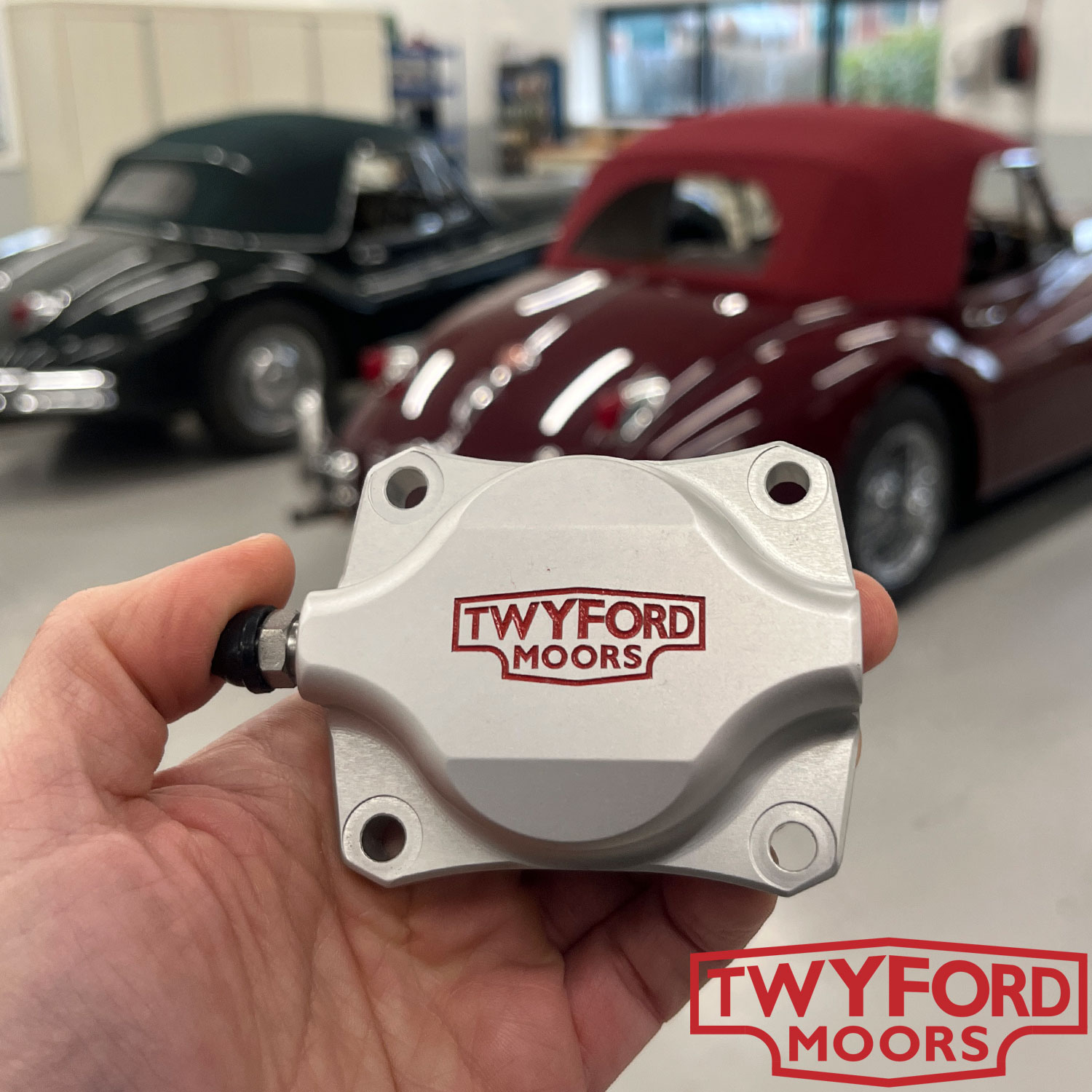
Daimler V8 Oil Leaks
At first glance, you might think this is a MkII saloon, but it is in fact its Daimler V8-powered cousin. We look after quite a number of these saloons and keep many of the required parts in stock, as they share so much in common with the Jaguar MkII.
This Daimler visited us last summer for a service and underwent a full inspection at the time. As part of this inspection, we identified a number of quite severe oil leaks, including from the engine and gearbox sumps. Interestingly, these V8 engines don’t use a sump gasket—they have a front and rear seal and rely on sealant between the mating faces to seal the sump.
To remove the sump on these saloons, it is best to drop the front subframe. This is a relatively straightforward procedure with the right equipment, as shown here. At this stage, it is well worth checking the subframe mounts, as they can perish over time and negatively impact the car’s ride and handling if in poor condition. With the subframe removed, the offending oil leaks were swiftly dealt with, the subframe mounts were renewed where required, and everything was reassembled.
This Daimler is now ready for plenty of fun in 2025, with oil leaks kept to a minimum!
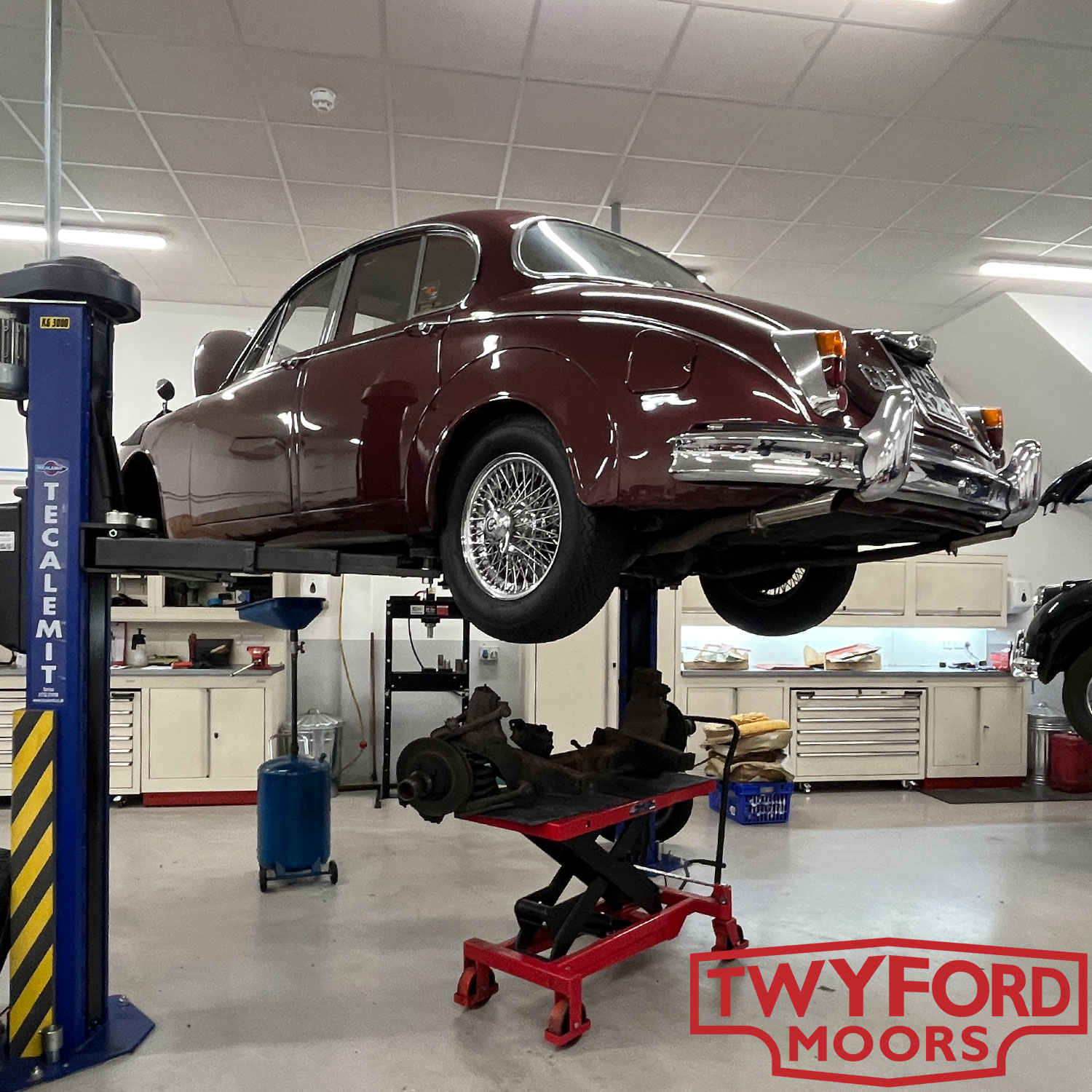
Jaguar XK140 Aluminium Radiator
Pictured here is an aluminium radiator, ready to be fitted to the XK140 in the background. The car's original radiator had sprung a leak from its core. Although we can have these re-cored, the owner of this XK wanted to improve its cooling with a high-capacity aluminium radiator.
We are always happy to cater for all preferences, whether originality or upgrades, but we find that the vast majority of owners prefer sympathetic enhancements to keep their cars usable. As seen in the photo, this radiator is also fitted with an electric cooling fan at the rear, which significantly improves cooling compared to the original engine-driven fan. The fan is neatly hidden behind the radiator, maintaining the car’s standard appearance.
This XK140 is one of many classics that visit us from the Channel Islands. There seems to be quite a community of classic car enthusiasts in Jersey and Guernsey, with XKs proving particularly popular. We are ideally positioned to support these customers, as they can take the ferry to Portsmouth, and we are just a short drive from the ferry terminal.
It has even been suggested a few times that we should set up a workshop in the Channel Islands to save these cars the crossing!
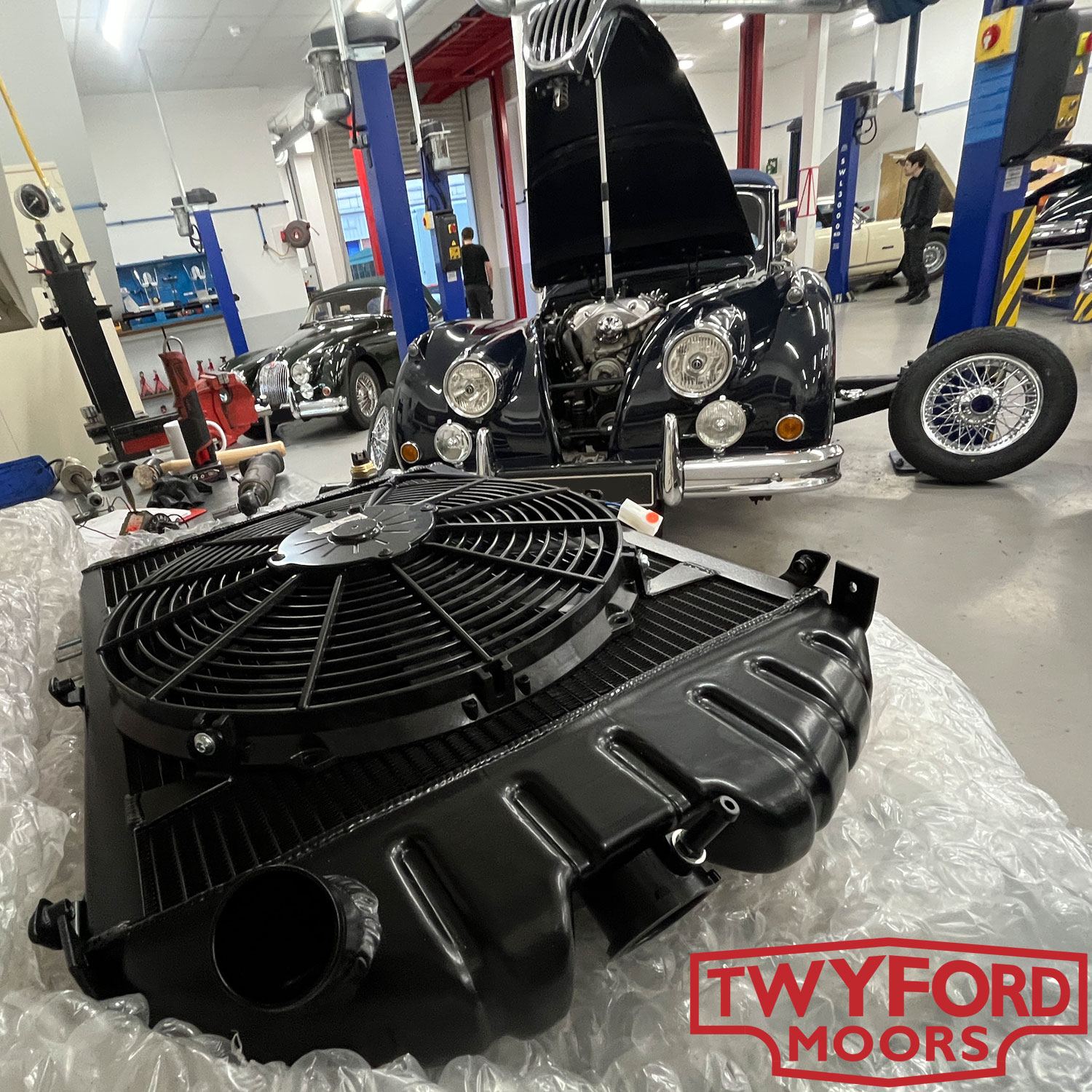
Modern Classics
Modern classics are hard to define. The XJS pictured here was certainly once considered a modern classic, but I wonder if it is now drifting into the realm of a classic car? Footman James suggests that a modern classic, or “Youngtimers” as they are known on the continent, generally refers to cars built from the 1980s, ’90s, and even into the 2000s. Let me know what you think of this as a definition.
This is certainly an interesting area of the car market at the moment. I feel there are some real opportunities, with some cars still being massively undervalued for what they are. I think people are starting to recognise the XJS for the wonderful GT that it truly is, but the XK8 and XKR that followed can still be picked up for absolute bargain prices. One major issue with this era of cars is poor maintenance. Many examples have suffered in recent years, as low values mean owners aren’t willing to invest in proper upkeep. Add to this the fact that main dealers aren’t interested in looking after them, and that your average garage doesn’t really want to get too deeply involved with an XK8, and you can see the challenge owners face.
All this leads me to a question: is there a demand for these cars to be properly maintained, or do their lower values prevent this? We already look after a few modern classics, and we are frequently asked to take on newer and newer cars. If you have a modern classic and would be interested in a garage like ours accommodating you, please let us know.
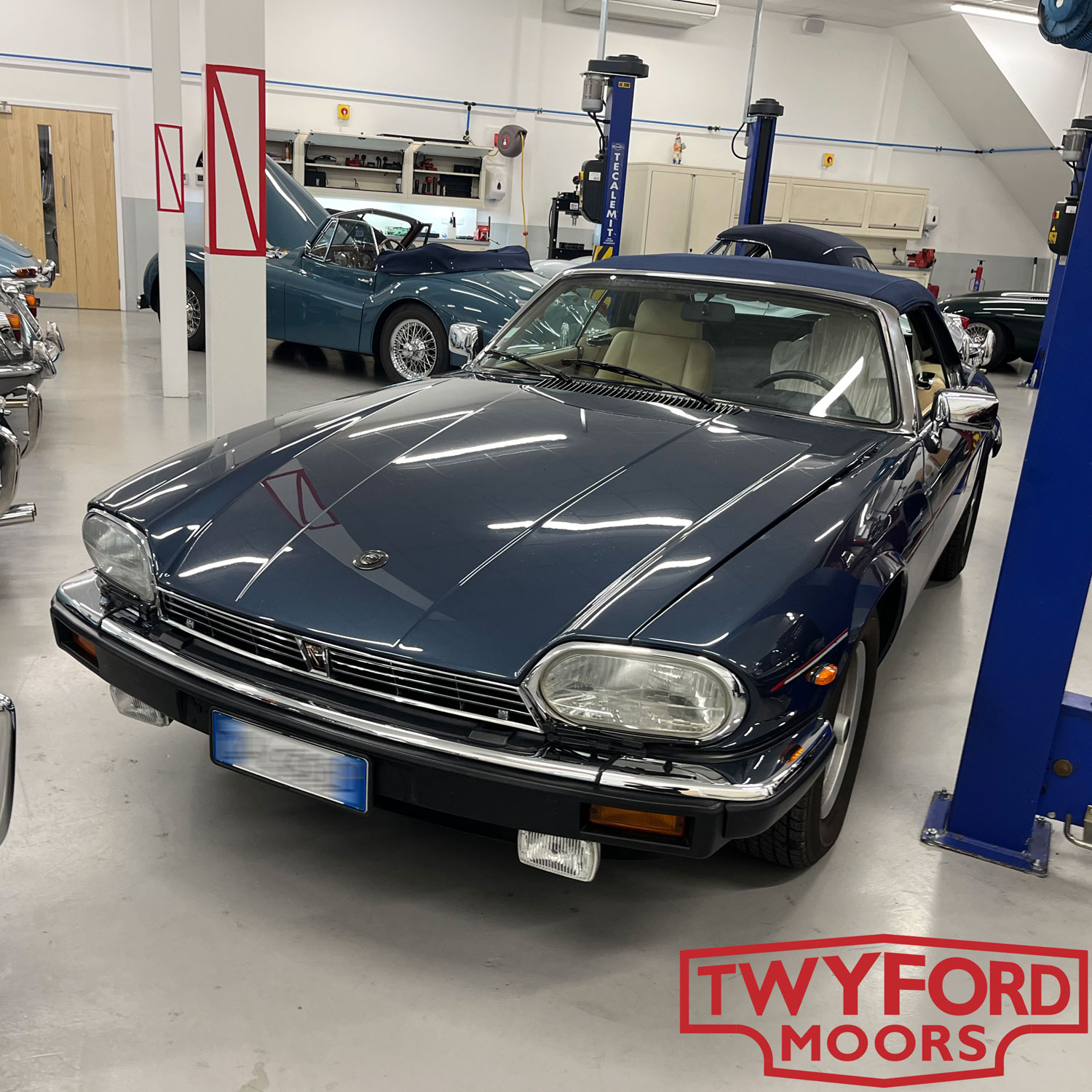
A Pair of Gordon-Keebles
Gordon-Keebles are an exceptionally rare car, with only 100 ever produced. The chances of having two in our workshop at the same time are pretty slim—but here we are, with these two great examples both in for servicing. We are one of the very few specialists recommended by the Gordon-Keeble Owners’ Club to maintain these cars, so perhaps it isn’t quite so surprising.
Although we are XK and E-Type specialists, we have a soft spot for the Gordon-Keeble, particularly as they were manufactured just up the road from us in Eastleigh. Their combination of Italian styling by Bertone and the V8 grunt of the Chevrolet 283 engine is hard not to love. Top that off with the marque’s choice of a tortoise for their emblem, and there’s something wonderfully eccentric and unique about this rare British classic.
Both of these cars are annual visitors to us and are here for a routine service. Neither required any major work beyond the usual maintenance expected over years of use. One challenge with cars like these is sourcing parts. Many components are shared with other classics and can be obtained, but the trick is knowing exactly what you’re looking for in the first place!
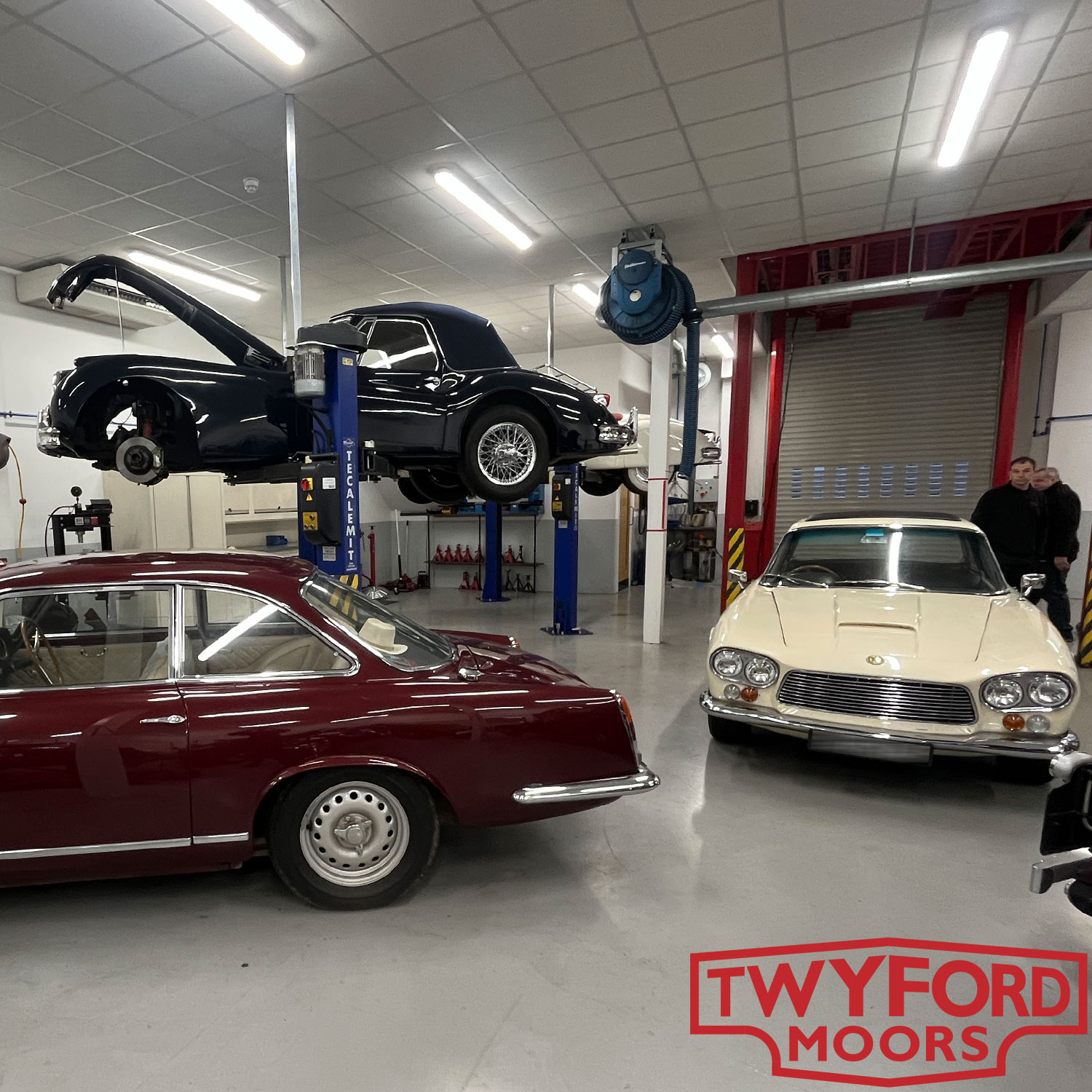
Jaguar XJC Refresh
Leaking sumps seem to be a theme this month—or perhaps they’re just a theme for classic cars in general! Anyway, here’s a new photo of the Jaguar XJC we shared last month, this time from a different angle.
With the car now running properly, the owner asked us to give it a thorough check-over and advise on any necessary work. Overall, the car is in fantastic condition, as can be seen from the photo, but there were a few items that required attention. The brake hoses were perished and needed replacing, a number of the water hoses were also perished, and a few gaskets were leaking, so these were replaced along with a new thermostat for good measure.
One of the bigger tasks was addressing a leaking sump. Bottom-end oil leaks on XK engines are often blamed on the notoriously poor rear main oil seal. Although this is frequently the culprit, it is always worth investigating properly to ensure the leak isn’t coming from elsewhere, as it could be due to a failed gasket or seal on the sump, or even the oil filter or return hose. In this case, the sump seals were indeed responsible, so we set about replacing them.
As you can see from this picture, the front subframe must be dropped and the engine supported from above to change the gaskets.
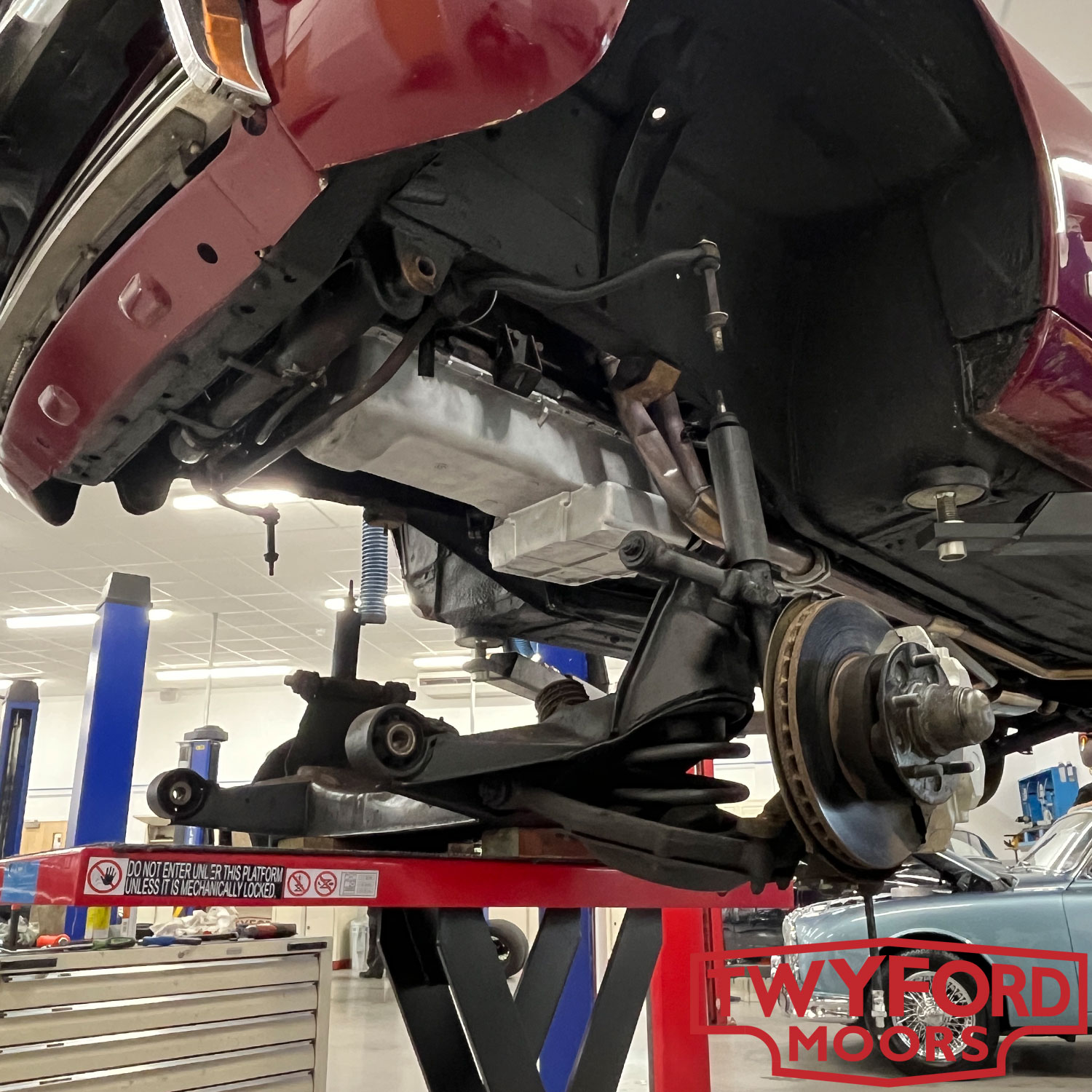
Jaguar E-Type Servicing
This is our sympathetically restored Jaguar E-Type, which we completed a couple of years ago. Although many of the mechanical components needed a rebuild, the wiring was in poor condition, and the body was looking rather tired, the car was fundamentally sound and quite original. We carefully stripped it down, attended to body repairs where necessary, and resprayed it in its original Signal Red. All the mechanical components were fully rebuilt, from powder-coated suspension to a fast road-specification engine.
We also made some light upgrades, including electronic ignition, polyurethane suspension bushes, and a lovely stainless steel exhaust system. This car was our test vehicle for fitting our first Toyota five-speed gearbox to an E-Type, which was a challenging but worthwhile process. Using what we learned from this car, we have successfully fitted many since.
The car is back in the workshop for its annual service and to attend to a few minor issues picked up during its shakedown miles. It has taken us a while to get around to these jobs, as customers' cars must always come first. We hope to be out and about in this E-Type more this year, so do watch out for it at shows!
